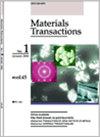Early-Stage Dislocation Structures inside the Dislocation Channels of Face-Centered-Cubic Metals with Point Defect Clusters
IF 1.9
4区 材料科学
Q4 MATERIALS SCIENCE, MULTIDISCIPLINARY
引用次数: 0
Abstract
Early-stage dislocation structures inside dislocation channels of rapid-cooled and tensile-deformed aluminum single crystals were investigated by using the bright field imaging mode in a scanning transmission electron microscope (STEM-BF). Inside dislocation channels, arrays of the prismatic dislocation loops originated from dislocations of the primary slip system, i.e., (1 1 1)[1 0 1], were mainly formed. Dislocations of the primary coplanar slip systems such as (1 1 1)[0 1 1] and (1 1 1)[1 1 0] were activated owing to internal stresses caused by the primary dislocations pile-up inside the cleared channels. The activated primary coplanar dislocations left the dislocation loops elongating along the edge dislocation directions behind them. Inter-dislocation-loop interactions occur especially at the arrays of the prismatic dislocation loops originated from dislocations of the primary slip systems and produce “butterfly shape” dislocation loops. As the “butterfly shape” dislocation loops have “sessile” junctions, they should act as “obstacles” against the following multiplications and glides of the dislocations. When the interactions proceed, “tangled structures” would be formed around the arrays of the prismatic dislocation loops originated from dislocations of the primary slip system.具有点缺陷团簇的面心立方金属位错通道内的早期位错结构
利用扫描透射电子显微镜(tem - bf)的亮场成像模式,研究了快速冷却和拉伸变形铝单晶位错通道内的早期位错结构。位错通道内主要形成源自原生滑移系统位错的棱柱位错环阵列,即(1 1 1)[1 0 1]。(1 1 1)[0 1 1]和(1 1 1)[1 1 1]等初级共面滑移体系的位错被激活是由于清除通道内堆积的初级位错所引起的内应力。激活的初级共面位错使位错环沿着其后面的边缘位错方向拉长。位错-位错环之间的相互作用主要发生在原始滑移体系位错形成的棱柱位错环的阵列上,形成“蝴蝶形”位错环。由于“蝴蝶形”的位错环具有“坚固”的连接点,它们应该作为“障碍”来阻止接下来的位错增殖和滑动。当相互作用进行时,原始滑移系统的位错引起的棱柱位错环阵列周围会形成“缠结结构”。
本文章由计算机程序翻译,如有差异,请以英文原文为准。
求助全文
约1分钟内获得全文
求助全文
来源期刊

Materials Transactions
工程技术-材料科学:综合
CiteScore
2.00
自引率
25.00%
发文量
205
审稿时长
2.7 months
期刊介绍:
Information not localized
 求助内容:
求助内容: 应助结果提醒方式:
应助结果提醒方式:


